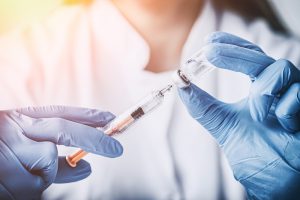Injectable Solution May Provide Weeks of Glucose Control

A technology that might provide weeks of glucose control for type 2 diabetes (T2DM) in a single injection—a potentially dramatic improvement over current therapies—has been developed by biomedical engineers at Duke. In primates, the treatment has been shown to last for weeks, rather than days.
By creating a controlled-release mechanism to optimize the drug’s circulation time in the body, the new biopolymer injection has the potential to replace daily or weekly insulin injections with once- or twice-monthly injections.
The new therapy was described in an article published in June 2017 in Nature Biomedical Engineering. David D’Alessio, MD, chief of the Duke Division of Endocrinology, Metabolism, and Nutrition, was an author of the paper; Ashutosh Chilkoti, PhD, chair of the Duke Department of Biomedical Engineering, was a senior author.
Many current treatments for T2DM use a glucagon-like peptide-1 (GLP-1) to cause the pancreas to release insulin to control blood sugar. However, this peptide has a short half-life and is cleared from the body quickly.
In an effort to make treatments last longer, researchers had previously fused GLP-1 with synthetic microspheres and biomolecules like antibodies, making them active for 2 to 3 days in mice and up to 1 week in humans. Despite this improvement, many of these treatments do not include a mechanism to control the rate of the peptide’s release, causing the drug’s effectiveness to plateau after prolonged use.
“The compound developed by Dr. Chilkoti and colleagues has a novel mechanism of sustained activity and has the potential to open up new avenues of drug development that could add to the utility of the GLP-1 drug class,” says D’Alessio.
He cautioned, however, that the effectiveness among patients is not clear. “This therapy ‘may’ be better tolerated and ‘might’ improve patient outcomes due to convenience,” D’Alessio says.
Despite a variety of treatment options, T2DM patients don’t always reach their glycemic targets, and adherence to treatment plans that rely on frequent, meal-specific dosing leaves room for human error, D’Alessio says. The new therapy could reduce the number of injections a person would need to control their glucose levels—a potentially significant improvement on current treatment options.